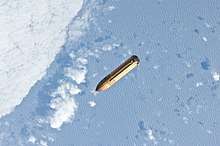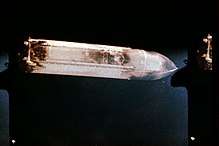List of reentering space debris
This "List of large reentering space debris" is a list of man made objects reentering Earth's atmosphere by mass (see space debris). Many small objects such as CubeSats are destroyed by reentry heating, but some larger objects or components can survive. Most of the objects which reenter are relatively small; larger objects have survived but usually break up into smaller pieces during reentry.[1][2][3]


The STS program (the Space Shuttle) launched 134 external tanks into space, they could weigh empty 78,100 pounds (35,425.6 kg), although they were not necessarily completely empty when discarded.[4] There was several different tanks with different weights, including the Standard weight, Lightweight, and Super Lightweight Tank. In general the heavier tanks were early, and over the decades new materials and removal of unnecessary features brought the mass down. The tanks fueled the spacecraft's acceleration to orbital velocity, after which they could be discarded and the STS then used its Orbital Maneuvering System which used a different fuel and engines
- Standard weight tank used for first few missions with variations such if they were painted and the anti-geyser line.
- Lightweight tank used primarily from 1983–1998, about 30,000 kg (66,000 lb)[5] (Ranged from 68k to 66k lbs over the years)[5]
- Super Lightweight Tank, used after 1998, about 58,000 lb[6]
Many other launch systems have discarded spent stages into space, but not all stages go into orbit or even space. For comparison the STS side boosters did not reach space.
Examples of heaviest re-entering spacecraft or components
| Object | Owner | Mass | Reentry Date | Age[7] | Reentry type | Launch Date[7][8] |
|---|---|---|---|---|---|---|
| Mir | Russia | 120,000 kg (260,000 lb) | 23 March 2001 | 15 years | Controlled | 20 February 1986 |
| Skylab[3] | USA | 69,000 kg (152,000 lb) | 11 July 1979 | 6 years | Uncontrolled | 14 May 1973 |
| Salyut 7/Cosmos 1686 | USSR | 40,000 kg (88,000 lb) | 7 February 1991 | 8 years | Uncontrolled | 13 May 1982 |
| STS External Tank (Standard Tank) | USA | 35,000 kg (77,000 lb)+remaining fuel | 1981 (1981–83) | Partially Controlled | ||
| Salyut 6/Cosmos 1267 | USSR | 35,000 kg (77,000 lb) | 29 July 1982 | 4 years | Controlled | 29 September 1977 |
| STS External Tank (Lightweight Tank) | USA | 30,000 kg (66,000 lb)+remaining fuel | 1983 (1983–98) | Partially Controlled | 1981-2011 | |
| Cosmos 557 | USSR | 19,400 kg (42,800 lb) | 22 May 1973 | 11 days | Uncontrolled | 11 May 1973 |
| Salyut 5 | USSR | 19,000 kg (42,000 lb) | 8 August 1977 | 1 year 2 months | Controlled | 2 June 1976 |
| Salyut 1 | USSR | 18,900 kg (41,700 lb) | 11 October 1971 | 5 months 22 days | Controlled | 19 April 1971 |
| Salyut 3 | USSR | 18,900 kg (41,700 lb) | 24 January 1975 | 6 months 30 days | Controlled | 25 June 1974 |
| Salyut 4 | USSR | 18,900 kg (41,700 lb) | 2 February 1977 | 2 years 1 month | Controlled | 26 December 1974 |
| Apollo SA-5 Nose Cone | USA | 17,100 kg (37,700 lb) | 30 April 1966 | 2 years 3 months | Uncontrolled | 29 January 1964 |
| Apollo SA-6 CSM BP-13 | USA | 16,900 kg (37,300 lb) | 1 June 1964 | 4 days | Uncontrolled | 28 May 1964 |
| Apollo SA-7 CSM BP-15 | USA | 16,650 kg (36,710 lb) | 22 September 1964 | 4 days | Uncontrolled | 18 September 1964 |
| Cosmos 929 | USSR | 15,000 kg (33,000 lb) | 2 February 1978 | 6 months 16 days | Controlled | 17 July 1977 |
| Cosmos 1443 | USSR | 15,000 kg (33,000 lb) | 19 September 1983 | 6 months 17 days | Controlled | 2 March 1983 |
| CGRO[3] | USA | 14,910 kg (32,870 lb) | 4 June 2000 | 9 years | Controlled | 5 April 1991 |
| Phobos-Grunt[9] | Russia | 13,500 kg (29,800 lb) | 15 January 2012 | 2 months 6 days | Uncontrolled | 9 November 2011 |
| Pegasus 1 | USA | 10,297 kg (22,701 lb) [10] | 17 September 1978[11] | 13 years | Uncontrolled | 16 February 1965 |
| Pegasus 2 | USA | 9,058 kg (19,969 lb)[10] | 3 November 1979[11] | 14 years | Uncontrolled | 25 May 1965 |
| Tiangong-1 | China | 8,506 kg (18,753 lb) | 2 April 2018[12] | 6 years | Uncontrolled | 29 Sep 2011 |
| UARS[13] | NASA | 5,900 kg (13,000 lb) | 24 September 2011 | 20 years | Uncontrolled | 12 September 1991 |
| ROSAT[14] | DLR | 2,400 kg (5,300 lb) | 23 October 2011 | 21 years | Uncontrolled | 1 June 1990 |
See also
- Center for Orbital and Reentry Debris Studies
- Space Shuttle external tank
- List of heaviest spacecraft
- List of space debris producing events
References
- "Largest Objects to Reenter". Center for Orbital and Reentry Debris Studies. Archived from the original on 2012-02-01. Retrieved 2012-01-22.
- Orbiting Debris: A Space Environmental Problem-Background Paper (PDF) (OTA-BP-ISC-72 ed.). U.S. Congress, Office of Technology Assessment. October 1990.
- Larsen, Francis Lyall, Paul B. (2009). Space law : a treatise ([Online-Ausg.]. ed.). Farnham, Surrey, England: Ashgate. pp. 114–121. ISBN 0-7546-4390-5.
- For composite objects such as space stations, age and launch date are based on the first launched module.
- McDowell, Jonathan. "Launch Log". Jonathan's Space Page. Retrieved 20 December 2010.
- Amos, Jonathan (15 January 2012). "Phobos-Grunt: Failed probe 'falls over Pacific'". BBC.
- "World Civil Satellites 1957-2006". Space Security Index. Archived from the original on 18 July 2011. Retrieved 20 December 2010.
- McDowell, Jonathan. "Satellite Catalog". Jonathan's Space Page. Retrieved 20 December 2010.
- 18 Space Control Squadron. "18 SPCS on Twitter". Twitter. Retrieved 2 April 2018.
UPDATE: #JFSCC confirmed #Tiangong1 reentered the atmosphere over the southern Pacific Ocean at ~5:16 p.m. (PST) April 1. For details see http://www.space-track.org @US_Stratcom @usairforce @AFSpaceCC @30thSpaceWing @PeteAFB @SpaceTrackOrg
- Justin Mullins, Paul Marks (20 September 2011). "Hardy 6-tonne satellite falls to Earth". New Scientist. Retrieved 25 September 2014.
"This is the largest NASA satellite to come back uncontrolled for quite a while," says Nick Johnson, chief scientist for NASA's Orbital Debris Program Office at the Johnson Space Center in Houston, Texas.
CS1 maint: uses authors parameter (link) - Paul Marks (23 September 2011). "Second big satellite set to resist re-entry burn-up". New Scientist. Retrieved 25 September 2014.